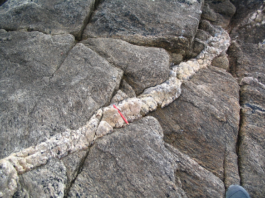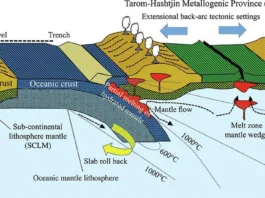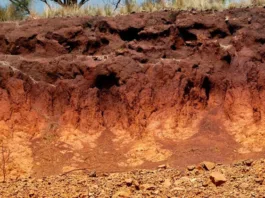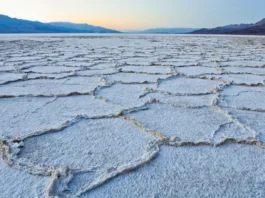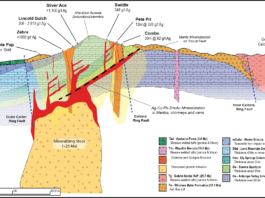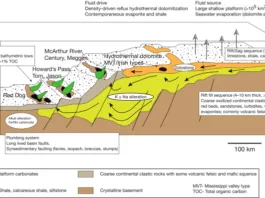Porphyry deposits are a type of mineral deposit that form from large-scale hydrothermal systems associated with intrusive igneous rocks. They are characterized by the presence of porphyritic rocks that contain large crystals (phenocrysts) surrounded by a fine-grained matrix (groundmass). The mineralization in porphyry deposits is typically associated with hydrothermal fluids that circulate through the porphyritic rocks, depositing minerals such as copper, gold, molybdenum, and silver in the form of sulfides and other minerals.
Contents
General Characteristics of Porphyry Deposits:
- Large scale: Porphyry deposits are large in size, often covering several square kilometers.
- Age: Porphyry deposits typically form in a relatively short time period, typically 1 to 5 million years after the formation of the associated intrusive igneous rock.
- Mineralization: Porphyry deposits are typically mineralized with copper, gold, molybdenum, and silver. The minerals are typically found as sulfides and other minerals in the form of veins and disseminations.
- Geology: Porphyry deposits are associated with intrusive igneous rocks, such as granites and diorites. The mineralization is typically related to hydrothermal fluids that circulate through the porphyritic rocks, depositing minerals as they cool and equilibrate with the surrounding rock.
Modeling of Porphyry Deposits:
- 3D geological modeling: 3D geological modeling is used to create a digital representation of the geometry and mineralization of a porphyry deposit. This model can be used to evaluate the distribution of minerals, the orientation of mineralization, and the size and shape of the deposit.
- Resource estimation: Resource estimation is used to estimate the size and grade of a porphyry deposit based on drilling and other geological data. This information is used to estimate the economic value of the deposit.
- Grade-tonnage modeling: Grade-tonnage modeling is used to estimate the relationship between the grade and size of a porphyry deposit. This information is used to estimate the size of the deposit and the potential for further exploration.
- Hydrothermal modeling: Hydrothermal modeling is used to evaluate the conditions under which the mineralization in a porphyry deposit formed, such as temperature, pressure, and fluid chemistry. This information is used to understand the processes that led to the formation of the deposit and to guide future exploration.
Overall, the modeling of porphyry deposits is an important tool for evaluating the potential of these deposits and for guiding exploration and development activities.
The Basics
The basics of porphyry deposits can be summarized as follows:
- Definition: Porphyry deposits are a type of mineral deposit that form from large-scale hydrothermal systems associated with intrusive igneous rocks.
- Characteristics: Porphyry deposits are characterized by the presence of porphyritic rocks that contain large crystals (phenocrysts) surrounded by a fine-grained matrix (groundmass). The mineralization in porphyry deposits is typically associated with hydrothermal fluids that circulate through the porphyritic rocks.
- Minerals: Porphyry deposits are typically mineralized with copper, gold, molybdenum, and silver. The minerals are typically found as sulfides and other minerals in the form of veins and disseminations.
- Geology: Porphyry deposits are associated with intrusive igneous rocks, such as granites and diorites. The mineralization is typically related to hydrothermal fluids that circulate through the porphyritic rocks.
- Modeling: Modeling is used to evaluate the potential of porphyry deposits, including 3D geological modeling, resource estimation, grade-tonnage modeling, and hydrothermal modeling. These models help to understand the size, shape, and mineralization of the deposit and to guide exploration and development activities.
The Basics: Field features
The field features of porphyry deposits include the following:
- Intrusive Rocks: The main host rocks for porphyry deposits are intrusive igneous rocks, such as granites and diorites. These rocks form from the slow cooling of magma in the Earth’s crust and provide the setting for the formation of porphyry deposits.
- Hydrothermal Alteration Zones: Porphyry deposits are associated with hydrothermal alteration zones, which are areas where the host rocks have been altered by the circulation of hot, mineral-rich fluids. The alteration zones are typically characterized by changes in rock type, color, and mineralogy, and are important indicators of the presence of mineralization.
- Veins and Disseminations: The mineralization in porphyry deposits is typically found in the form of veins and disseminations. Veins are narrow, linear zones of mineralization that have been precipitated from the hydrothermal fluids. Disseminations are more widespread and consist of minerals that have been distributed throughout the host rocks.
- Copper Skarns: Porphyry deposits are often associated with copper skarns, which are zones of mineralization that form at the contact between an intrusive igneous rock and a carbonate rock, such as limestone. Copper skarns are an important source of copper, gold, and molybdenum.
- Geophysical Anomalies: Porphyry deposits can be identified using geophysical methods, such as magnetic, gravity, and electrical resistivity surveys. These methods are used to detect changes in the physical properties of the rocks that are indicative of the presence of mineralization.
These field features are important indicators of the presence of porphyry deposits and can be used to guide exploration and development activities. Understanding the field features of porphyry deposits is an essential aspect of modeling and evaluating the potential of these deposits.
Largest deposits:
The largest porphyry deposit in the world is the Escondida mine in Chile. This mine is the largest producer of copper in the world and also produces significant amounts of gold and silver. Other large porphyry deposits include the Grasberg mine in Indonesia, the Cadia mine in Australia, and the Piedra Buena mine in Argentina.
In addition to these large mines, there are many other porphyry deposits that are located throughout the world, including deposits in the Americas, Europe, Asia, and Africa. These deposits are an important source of copper, molybdenum, gold, and other minerals and are critical to the global economy.
It is worth noting that while some of the largest porphyry deposits are located in politically and economically stable regions, others are located in areas that are more challenging from a geopolitical and logistical perspective. This highlights the importance of understanding the regional and local factors that can impact the exploration, development, and production of these deposits.
Here is a list of some of the largest porphyry deposits in the world:
- Escondida mine, Chile
- Grasberg mine, Indonesia
- Cadia mine, Australia
- Piedra Buena mine, Argentina
- Bingham Canyon mine, United States
- Morenci mine, United States
- Cerro Verde mine, Peru
- El Teniente mine, Chile
- Ok Tedi mine, Papua New Guinea
- Freeport-McMoRan Sierrita mine, United States.
This list is not exhaustive and there may be other large porphyry deposits that are not included. It is important to note that the size of a deposit can change over time as mining and exploration activities continue.
Tectonic Setting
The tectonic setting is an important factor in the formation of porphyry deposits. Porphyry deposits are formed in areas where there has been significant tectonic activity and where magmatic intrusions have occurred. This activity can cause large-scale deformation and metamorphism in the surrounding rock, leading to the formation of mineral deposits.
Tectonic activity can also cause the formation of large-scale structures such as faults, which can act as conduits for the migration of mineral-rich fluids. These fluids can then interact with the surrounding rock, leading to the precipitation of minerals such as copper, molybdenum, and gold.
In general, porphyry deposits are associated with convergent plate boundaries, where two tectonic plates are moving towards each other. This type of tectonic setting is characterized by significant mountain building, large-scale faulting, and volcanic activity. The Andes mountain range in South America is an example of a region with a convergent plate boundary and a large number of porphyry deposits.
It is also worth noting that some porphyry deposits are formed in extensional tectonic settings, where tectonic plates are moving apart. In these settings, magma rises to the surface and cools to form large, porphyritic intrusions that are rich in copper, molybdenum, and other minerals.
Porphyry Model
Porphyry Cu Systems Granitic cupola at 3-10 km depth Hydrothermal alteration & ores at 1 to >6 km depth Central high sulfide & metals Increasing low pH, high fS2 alteration upward in system Transition from deep Ppy Cu to shallow epithermal environm’t Role of non-magmatic fluids traditionally restricted to dilute groundwater (meteoric)

Hypogene Mineralisation
Hypogene mineralization refers to the formation of minerals in subsurface environments. It is a term used in the context of mineral deposits, including porphyry deposits, to describe the process by which minerals are precipitated from mineral-rich fluids that have been derived from deeper within the Earth’s crust.
Hypogene mineralization is typically associated with magmatic systems that are characterized by the intrusion of magma into the surrounding rock. As the magma cools and solidifies, mineral-rich fluids are released and can migrate through the surrounding rock, leading to the precipitation of minerals such as copper, molybdenum, and gold.
This process can occur over long periods of time, with mineral-rich fluids circulating through the subsurface for millions of years before being expelled and precipitating minerals. The resulting mineral deposits can be extensive, with mineralization occurring over large areas and at great depths.
Hypogene mineralization is an important process in the formation of porphyry deposits and is responsible for the large quantities of copper, molybdenum, and other minerals that are present in these deposits. Understanding the processes involved in hypogene mineralization is important for mineral exploration and the development of new mines.
Genesis
The genesis of porphyry deposits refers to the origin and formation of these deposits. Porphyry deposits are formed through a combination of geological processes that take place over long periods of time. These processes include magmatism, hydrothermal activity, and the interaction of mineral-rich fluids with the surrounding rock.
The formation of porphyry deposits typically begins with the intrusion of magma into the Earth’s crust. As the magma cools and solidifies, mineral-rich fluids are released and can migrate through the surrounding rock. These fluids can then interact with the surrounding rock, leading to the precipitation of minerals such as copper, molybdenum, and gold.
Over time, the mineral-rich fluids can continue to circulate through the subsurface, leading to the formation of large, mineralized systems. The resulting deposits can be extensive, with mineralization occurring over large areas and at great depths.
The specific processes involved in the genesis of porphyry deposits can vary depending on the tectonic setting, the type of magma involved, and the age of the deposit. However, in general, porphyry deposits are formed through a combination of magmatic, hydrothermal, and metamorphic processes that take place over millions of years.
Understanding the genesis of porphyry deposits is important for mineral exploration and the development of new mines. It can help to identify areas where these deposits are likely to occur and to understand the processes involved in the formation of these deposits, which can impact the economics of mining.
Volatile Exsolution
Volatile exsolution refers to the process in which gases, such as water vapor and carbon dioxide, are separated or “exsolved” from a magma body. This process can occur as the magma cools, or as pressure changes due to magma movement or changes in the Earth’s crust.
During volatile exsolution, the gases are released from the magma and form separate pockets or bubbles within the magma. These pockets of gas can then interact with the surrounding rock, leading to the formation of mineral deposits, including porphyry deposits.
Volatile exsolution is an important process in the genesis of porphyry deposits because the exsolved gases can play a key role in the formation of mineralization. For example, the gases can carry metal ions and other minerals, which can be deposited in the surrounding rock. Additionally, the gases can change the chemistry of the surrounding rock, leading to the formation of mineral deposits.
Understanding the role of volatile exsolution in the genesis of porphyry deposits is important for mineral exploration and mining. It can help to identify areas where these deposits are likely to occur and to understand the processes involved in the formation of these deposits, which can impact the economics of mining.
Fertile Magma Production
Fertile magma production refers to the formation of magma that has the potential to form mineral deposits. The term “fertile” is used because these magmas are rich in elements that can form minerals, such as copper, gold, and molybdenum.
Fertile magma production can occur in a variety of tectonic settings and is thought to be related to the subduction of tectonic plates and the generation of magma in the Earth’s mantle. As tectonic plates converge and one plate is forced beneath another, the subducting plate is subjected to high pressures and temperatures, which can cause melting and the generation of magma.
The magma produced in this way is typically rich in elements that are derived from the subducting plate and can be important for the formation of mineral deposits. For example, porphyry copper deposits are often associated with fertile magmas that are rich in copper and other metals.
Fertile magma production is an important aspect of the genesis of porphyry deposits, and understanding the conditions that lead to the production of these magmas is important for mineral exploration and mining. It can help to identify areas where these deposits are likely to occur and to understand the processes involved in the formation of these deposits, which can impact the economics of mining.
Ore Formation
Ore formation is the process by which minerals with economic value, known as ore minerals, are formed and concentrated in the Earth’s crust. This process typically involves the concentration of ore minerals through geological processes such as weathering, erosion, and transportation, followed by the deposition of these minerals in concentrated areas such as veins, lodes, or other geological structures.
The specific processes that lead to the formation of ore deposits are complex and can vary depending on the type of deposit and the geological setting in which it occurs. Some of the factors that can influence ore formation include:
- Tectonic activity: Tectonic activity, such as plate convergence and mountain building, can create conditions that are favorable for ore formation. For example, the compression and heating that occur during mountain building can cause minerals to recrystallize and form ore deposits.
- Volcanism: Volcanic activity can also play a role in ore formation. For example, volcanic eruptions can release minerals from the Earth’s mantle and deposit them on the surface, where they can then be concentrated and form ore deposits.
- Hydrothermal activity: Hydrothermal activity, such as hot springs and geysers, can also be important for ore formation. These systems can transport minerals from the Earth’s interior and deposit them in concentrated areas, where they can form ore deposits.
- Weathering and erosion: Weathering and erosion can also play a role in ore formation. For example, the weathering and transportation of minerals from the Earth’s surface to lower elevations can lead to the concentration of minerals and the formation of ore deposits.
Understanding the processes that lead to ore formation is important for mineral exploration and mining, as it can help to identify areas where ore deposits are likely to occur and to understand the conditions that are favorable for ore formation. This information can be used to guide exploration efforts and to improve the economics of mining operations.
Hydrothermal Alteration
Hydrothermal alteration is a process by which rocks and minerals are altered or changed by hot, mineral-rich fluids that circulate through the Earth’s crust. The hot fluids can dissolve minerals and transport them to new locations, where they can precipitate and form new minerals. The resulting altered rock can contain minerals that are different from those in the original rock and may have different physical and chemical properties.
Hydrothermal alteration is a common process that occurs in many different geological environments, including volcanic systems, hot springs, geysers, and mineral deposits. It can play a key role in the formation of many different types of ore deposits, including porphyry copper deposits, epithermal gold deposits, and iron oxide-copper-gold (IOCG) deposits.
In summary, hydrothermal alteration is a process by which rocks and minerals are changed by hot, mineral-rich fluids. It can play a significant role in the formation of many different types of ore deposits, including porphyry copper deposits. Understanding the extent and nature of hydrothermal alteration is important for mineral exploration and mining, as it provides valuable information about the location and type of minerals present in an area.
References
- “Ore Geology and Industrial Minerals” by Anthony M. Evans
- “Introduction to Mineral Exploration” by Charles J. Moon, Michael K. G. Whateley, and Anthony M. Evans
- “Economic Geology: Principles and Practice” by Graeme J. Tucker
- “Mineral Deposits” by R. Peter King and Colin J. Sinclair
- “Mineral Deposits of the World” edited by Richard J. Hershey and Donald A. Singer.

